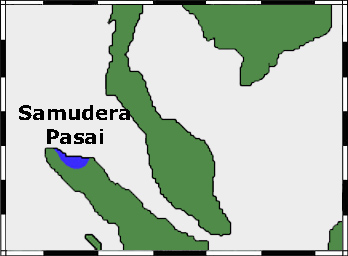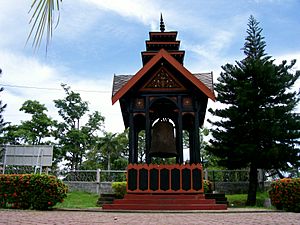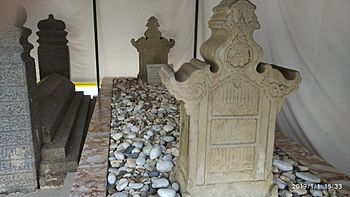Samudera Pasai Sultanate facts for kids
Quick facts for kids
Samudera Pasai Sultanate
كسلطانن سامودرا ڤاساي
|
|||||||||||
|---|---|---|---|---|---|---|---|---|---|---|---|
| 1267–1521 | |||||||||||

Map of Pasai, at today's Lhokseumawe of Sumatra, Aceh province.
|
|||||||||||
| Capital | Pasai | ||||||||||
| Common languages | Malay language | ||||||||||
| Religion | Sunni Islam | ||||||||||
| Government | Monarchy | ||||||||||
| Sultan | |||||||||||
|
• 1267–1297
|
Malik ul Salih (founder) | ||||||||||
|
• 1514–1517
|
Zainal Abidin IV (last) | ||||||||||
| History | |||||||||||
|
• Coronation
|
1267 | ||||||||||
|
• Portuguese invasion
|
1521 | ||||||||||
| Currency | Dirham coins | ||||||||||
|
|||||||||||
| Today part of | Indonesia | ||||||||||
The Samudera Pasai Sultanate was an important Muslim kingdom. It was located on the northern coast of Sumatra from the 13th to the 16th centuries. People also called it Samudera or Pasai.
This kingdom was started by a person named Merah Silu. He later became Muslim and took the name Malik ul Salih in the year 1267 CE. Not much information is left about this kingdom today.
Contents
What's in a Name?
Where Did "Samudera" Come From?
The name 'Samudera' might come from an old story. It talks about a very large ant, as big as a cat! Merah Silu found this ant while hunting. He was on a high piece of land.
He decided to clear that land to build a new state. He named it 'Semudera' after the giant ant. Another idea is that 'Samudera' comes from the word for 'ocean' in Sanskrit and Tamil.
How Did "Pasai" Get Its Name?
The name 'Pasai' also has a cool story. It comes from Si-Pasai, the hunting dog of Sultan Malik al Salleh. This was Merah Silu after he became Muslim.
The story says the Sultan was hunting with his dog. They met a deer that barked back at the dog! The Sultan was amazed. He thought it was a good sign to build a new state for his son there. The dog died after the state was built. The Sultan buried his dog there and named the place after it.
In the 14th century, a traveler from Italy named Odoric of Pordenone called Samudra "Sumoltra." Later, other European writers used similar names for the whole island of Sumatra.
History of the Sultanate
Spreading Culture and Language
Pasai shared its culture with many islands. Most importantly, it spread its language. This was an early form of Malay written in the Jawi alphabet. This language later became very important for traders. It was used in what is now Indonesia and Malaysia.
Early Muslim Kingdoms
Arab and Indian Muslim traders had been in Indonesia and China for many centuries. But strong proof of Islam in Indonesia starts in northern Sumatra in the late 1200s.
By then, two small Muslim trading kingdoms existed. These were Pasai and Peureulak. A royal tomb from 1297 in Samudra has writing only in Arabic. By the 1400s, many harbor kingdoms grew. They were all ruled by local Muslim princes. These kingdoms stretched from Java to the Maluku.
Famous Travelers Visit Pasai
Marco Polo, a famous traveler, stayed in this area for five months. He wrote about places like Ferlec, Basma, and Samara (Samudera). Another well-known traveler, Ibn Battuta, stayed in Samudera for 15 days on his way to China.
Pasai became a Muslim center because of trade. In the 1200s, the power of Srivijaya weakened. This brought foreign traders to harbors on Sumatra's northern coast. These harbors were safe from pirates. Northern Sumatra had lots of gold and forest products. They also started growing pepper in the early 1400s. This made it a great place for all merchants to meet ships from the Indian Ocean.
In 1345, Ibn Battuta, a traveler from Morocco, visited Samudra Pasai. He wrote that the ruler of Samudera Pasai was a very religious Muslim. He followed his religious duties with great care. Ibn Battuta praised the Sultan's kindness. He stayed for about two weeks as a guest. Then the Sultan gave him supplies and a ship to China.
Changes and Challenges
The Hongwu Emperor of China's Ming Dynasty listed Samudera as one of 14 countries. He said China should not attack these countries. By the end of the 1300s, Samudra-Pasai was a rich trading center. But in the early 1400s, it lost some importance to Malacca. Malacca was a better protected harbor. The Majapahit kingdom attacked and robbed Pasai in the mid-1300s.
Pasai's power came mostly from foreigners. Muslim traders and teachers helped run the kingdom. They also brought in religious practices that made them feel at home. These first Muslim areas in Indonesia, especially Pasai, were truly Muslim places. They had the support of the local people and encouraged learning.
The End of the Sultanate
The Portuguese took over Pasai in 1521. This was 10 years after they conquered Malacca. The Portuguese called the place Pacem. Later, the Aceh people took control of Pasai.
Rulers of Samudera Pasai
Here is a list of the rulers of the Samudera Pasai Sultanate:
| No | Period | Name of Sultan or Title | Notes and important historical events |
|---|---|---|---|
| 1 | 1267–1297 | Sultan Malikussaleh (Meurah Silu) | Founder of Samudra Pasai kingdom |
| 2 | 1297–1326 | Sultan Al-Malik azh-Zhahir I / Muhammad I | Started using gold coins |
| 3 | 1326 – 133? | Sultan Ahmad I | Attacked the Karang Baru Kingdom |
| 4 | 133? – 1349 | Sultan Al-Malik azh-Zhahir II | Visited by Ibnu Batutah |
| 5 | 1349–1406 | Sultan Zainal Abidin I | Attacked by Majapahit |
| 6 | 1406–1428 | Ratu Nahrasyiyah | The most successful period for Samudra Pasai |
| 7 | 1428–1438 | Sultan Zainal Abidin II | |
| 8 | 1438–1462 | Sultan Shalahuddin | |
| 9 | 1462–1464 | Sultan Ahmad II | |
| 10 | 1464–1466 | Sultan Abu Zaid Ahmad III | |
| 11 | 1466–1466 | Sultan Ahmad IV | |
| 12 | 1466–1468 | Sultan Mahmud | |
| 13 | 1468–1474 | Sultan Zainal Abidin III | Overthrown by his brother |
| 14 | 1474–1495 | Sultan Muhammad Syah II | |
| 15 | 1495–1495 | Sultan Al-Kamil | |
| 16 | 1495–1506 | Sultan Adlullah | |
| 17 | 1506–1507 | Sultan Muhammad Syah III | Has two tombs |
| 18 | 1507–1509 | Sultan Abdullah | |
| 19 | 1509–1514 | Sultan Ahmad V | During the Capture of Malacca (1511) |
| 20 | 1514–1517 | Sultan Zainal Abidin IV |
Historical Discoveries
The tomb of Sultan Malik as-Saleh was found. It dates back to 1267 AD. Historians see this as a sign that Islam came to the Archipelago around the 13th century. Some think it might have arrived even earlier.
The stories of the Pasai Kings have many myths. But they help us learn about this kingdom's past. The kingdom's old glory still inspires people today. A university in Lhokseumawe is named after its founder, the University of Malikussaleh.
See also
 In Spanish: Reino de Samudra Pasai para niños
In Spanish: Reino de Samudra Pasai para niños



